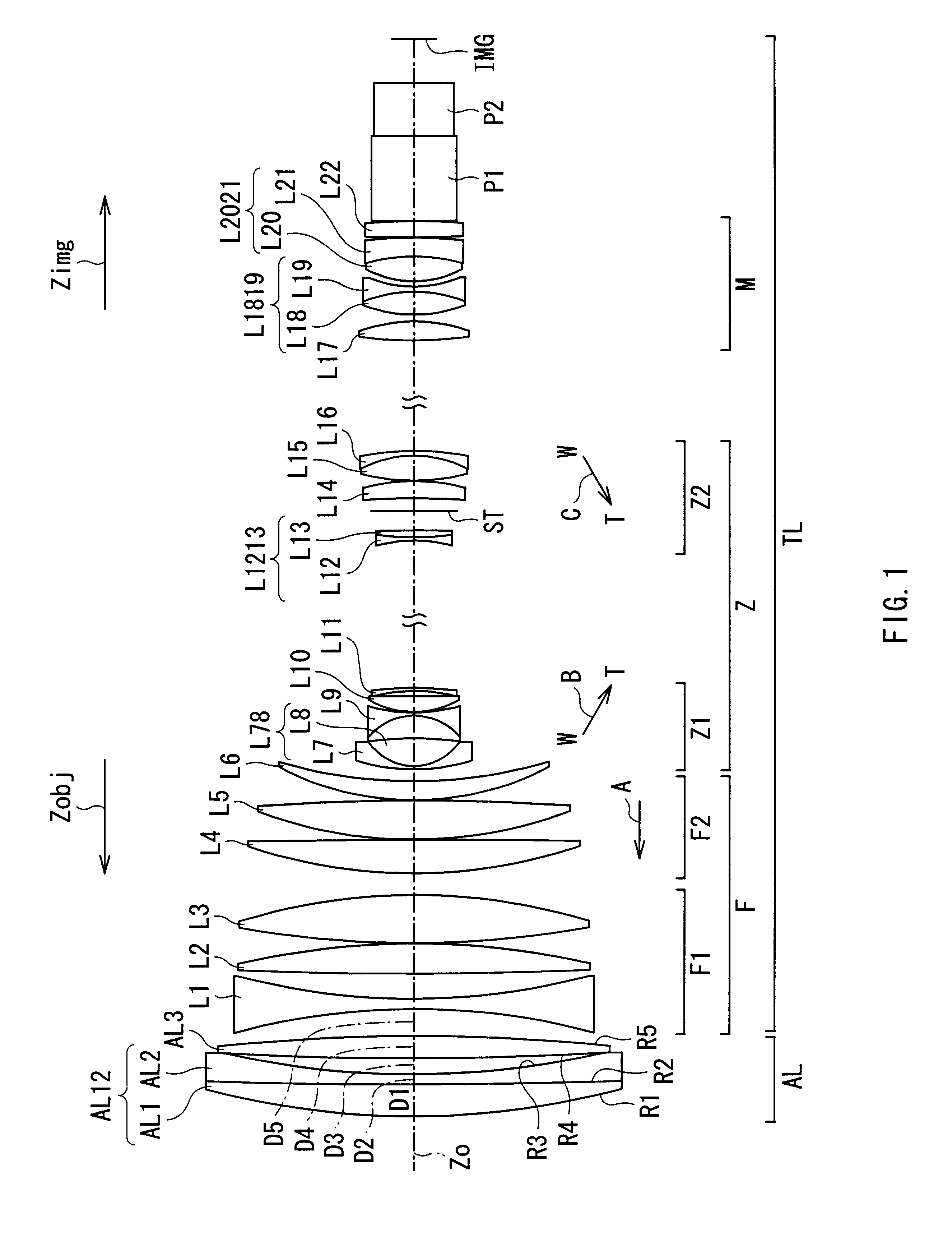Close-up attachment lens
a technology of attachment lens and lens body, which is applied in the field of close-up attachment lens, can solve the problems of difficulty in attaching lens, inapplicability to other taking lens bodies with different configurations, and large aberrations of various kinds,
- Summary
- Abstract
- Description
- Claims
- Application Information
AI Technical Summary
Benefits of technology
Problems solved by technology
Method used
Image
Examples
example 1
The cross-sectional configuration and the zoom system of an attachment lens and a taking lens body according to an example are the same as those shown in FIG. 1.
FIG. 2 shows a specific numerical data table regarding the configuration of the attachment lens AL of the example. In the table, the column of surface number Si shows the number of lens surface increasing as the lens surface is closer to the image plane side, assuming a lens surface closest to the object side is the first lens surface. The column of radius of curvature Ri corresponds to the symbol Ri shown in FIG. 1, and the column shows the radius of curvature of the ith lens surface from the object side. The column of surface separation Di also corresponds to the symbol Di shown in FIG. 1, and the column shows the surface separation in a direction of the optical axis between the ith lens surface Si from the object side and the i+1th lens surface Si+1. The radius of curvature Ri and the surface separation Di are expressed i...
example 2
The cross-sectional configuration and zoom system of the attachment lens and the taking lens body according to another example are the same as those shown in FIG. 1.
FIG. 7 shows specific numerical data regarding the configuration of the attachment lens AL of the example. The attachment lens AL of the example has a focal length of 600 mm.
In the example, a focal length f12 of the cemented lens AL12 is "-2400 mm", a focal length f3 of the third lens AL3 is "473 mm", so they satisfy the conditional expression (1). Further, like Example 1, the Abbe numbers vd1 and vd2 of the first lens AL1 and the second lens AL2 forming the cemented lens AL12 are "70.2" and "44.9", respectively, so they are within a range of the conditional expressions (2) and (3).
FIGS. 8A to 8C and FIGS. 9A and 9C show various aberrations at the wide end and at the tele end, respectively, in a state that the attachment lens AL of the example is mounted on the taking lens body TL. In the example, the overall focal lengt...
example 3
The cross-sectional configuration and zoom system of the attachment lens and the taking lens body according to a still another example are the same as those shown in FIG. 1.
FIG. 10 shows specific numerical data regarding the configuration of the attachment lens AL of the example. The attachment lens AL of the example has a focal length of 400 mm.
In the example, a focal length f12 of the cemented lens AL12 is "-1484 mm", a focal length f3 of the third lens AL3 is "311 mm", so they satisfy the conditional expression (1). Further, like Example 1, the Abbe numbers .nu.d1 and .nu.d2 of the first lens AL1 and the second lens AL2 forming the cemented lens AL12 are "70.2" and "44.9", respectively, so they are within a range of the conditional expressions (2) and (3).
FIGS. 11A to 11C and FIGS. 12A to 12C show various aberrations at the wide end and at the tele end, respectively, in a state that the attachment lens AL of the example is mounted on the taking lens body TL. In the example, the o...
PUM
 Login to View More
Login to View More Abstract
Description
Claims
Application Information
 Login to View More
Login to View More - R&D
- Intellectual Property
- Life Sciences
- Materials
- Tech Scout
- Unparalleled Data Quality
- Higher Quality Content
- 60% Fewer Hallucinations
Browse by: Latest US Patents, China's latest patents, Technical Efficacy Thesaurus, Application Domain, Technology Topic, Popular Technical Reports.
© 2025 PatSnap. All rights reserved.Legal|Privacy policy|Modern Slavery Act Transparency Statement|Sitemap|About US| Contact US: help@patsnap.com



